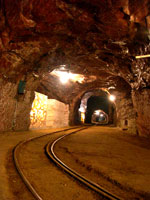
News |
- Budget Weakens Environmental Assessment
- Ontario Surfacewater Pesticide Contamination Drops 80%
- New Biosphere Reserves Selected
- Brandon to Reduce Landfill Greenhouse Gases
- Panel Rules Prosperity Mine Poses Significant Threats
- INCO to Pay Port Colborne Residents $36 Million
- Gwaii Haanas: Galapogos North Protected
- Canada Day Demonstrators Support Detainees
- Manitoba Hydro Shuts Down Jenpeg
- Journalists Arrested, Threatened at G20
- 180 Lawsuits Filed Against BP
- Mississaugas Paid for Deceitful Land Purchase
| Budget Weakens Environmental Assessment | 21 July 10 |
 The Canadian Senate passed the omnibus federal government budget bill (Bill C-9) on July 12, 2010, with previously deleted sections reinstated. Some environmental groups fear these sections weaken Canada's federal environmental assessment review process. The changes allow the Environment Minister discretion to define scope of environmental assessments. The Canadian Senate passed the omnibus federal government budget bill (Bill C-9) on July 12, 2010, with previously deleted sections reinstated. Some environmental groups fear these sections weaken Canada's federal environmental assessment review process. The changes allow the Environment Minister discretion to define scope of environmental assessments.Government politicians praised the budget's passage as just what is needed for a healthy economy, while critics said the government has made it easier for corporations to submit environmental assessments with only limited scope, or to avoid assessment altogether. "This sets us back 20 or 25 years in terms of environmental assessment in Canada. It's a huge step backwards," commented Sierra Club Canada executive director John Bennett. Critics say changes will "gut" the Act, and particularly weaken environmental oversights for new energy projects. Assessments could be carried out, not by the Canadian Environmental Assessment Agency, but by weaker, less experienced bodies. "The whole point of this, it's clear, is to push through major energy project. In the wake of the BP disaster, this is not the time to weaken environmental reviews of offshore oil and gas," said Elizabeth May, Leader of the Green Party . "It will be a miracle if these changes don't result in a disaster in some part of the Canadian environment because of the weakening of the review process." One positive changes is that federal authority for environmental assessments rests with the Canadian Environmental Assessment Agency, whose budget has been beefed up by 60% a year, or $11 million. View July 12, 2010 Hill Times articleView July 7, 2010 Winnipeg Sun article View July 6, 2010 Sierra Club article View July 8, 2010 Globe and Mail article View May 11, 2010 Ecojustice press release View July 12, 2010 Toronto Sun article View July 13, 2010 Toronto Star article View July 13, 2010 Globe-Net article Source: Winnipeg Sun, Globe-Net |
|
 Print version Print version |
Top |
| Ontario Surfacewater Pesticide Contamination Drops 80% | 21 July 10 |
 On April 22, 2009 Ontario regulations came into effect to ban pesticide use for most cosmetic purposes on lawns and gardens. The goal was to decrease water contamination and protect its citizens from toxic chemicals and pollutants. On April 22, 2009 Ontario regulations came into effect to ban pesticide use for most cosmetic purposes on lawns and gardens. The goal was to decrease water contamination and protect its citizens from toxic chemicals and pollutants.Authorities analyzed water samples over two years for pesticide concentration. In summers 2008 and 2009 (before and after the ban took effect), staff from Ontario Ministry of Environment and five conservation authorities conducted water quality monitoring studies of ten urban streams and creeks. They tested them for up to 105 pesticides and breakdown products. Results show in 2009 concentrations of the three most popular cosmetic pesticides dropped by more than 80 per cent: 2,4D reduced by 86 per cent followed by dicamba (82 per cent) and MCPP (2-methyl-4-chlorophenoxyacetic acid; 78 per cent). "The sort of thing we were hoping would happen: that kids would be protected, that water would be protected, that urban streams would be protected is happening, and it is very gratifying," stated Gideon Forman, Executive Director for the Canadian Association of Physicians for the Environment. More than 250 pesticide products are banned for sale in Ontario, and over 95 pesticide ingredients are banned for cosmetic uses. Exceptions exist for public health or safety, natural resources, golf courses, sports fields, specialty turf, trees, agriculture, forestry and public works projects. View Ontario Ministry of the Environment Urban Stream Quality Study (PDF)View March 4, 2009 Ontario Government website news release Listen to June 10, 2010 CBC Radio coverage (MP3) View July 7, 2010 Treehugger.com article View July 8, 2010 Beyond Pesticides press release View June 15, 2010 EnviroLaw.com blog View the Cosmetic Pesticides Ban Act (2008) (PDF) View Ontario Pesticide Act Regulation 63/09 Source: CBC Radio, Ontario Government, Ontario Ministry of the Environment |
|
 Print version Print version |
Top |
| New Biosphere Reserves Selected | 21 July 10 |
 The United Nations Educational, Scientific and Cultural Organization (UNESCO) has added 13 new sites and five extensions to the world network of biosphere reserves at the 22nd session of the International Coordination Council held in Paris, France May 31-June 4, 2010. The United Nations Educational, Scientific and Cultural Organization (UNESCO) has added 13 new sites and five extensions to the world network of biosphere reserves at the 22nd session of the International Coordination Council held in Paris, France May 31-June 4, 2010.Biosphere reserves are areas listed under UNESCO's Man and the Biosphere program. They serve as places to test integrated management of terrestrial, freshwater, coastal and marine resources and biodiversity. The first biosphere reserves in Ethiopia and Zimbabwe are among the new sites. One of the two new Ethiopian reserves includes the place of origin of the plant Caffea Arabica, believed to be the first species of coffee ever cultivated. The Council also added 10 biosphere reserve sites in Iran, Mexico, Nicaragua, Peru, Poland, Slovenia, South Korea, and Sweden, while five sites in Chile, Costa Rica, Finland, Germany and Switzerland were extended. The addition of 13 new sites brings the world biosphere reserves network to 564 in 109 countries, including 15 biosphere reserves in Canada. View June 2, 2010 UNESCO press releaseView June 2, 2010 CBC News article View June 5, 2010 Ethiopian News Agency article View June 7, 2010 Environmental News Service article Source: UNESCO, CBC News, Ethiopian News Agency, Environmental News Service |
|
 Print version Print version |
Top |
| Brandon to Reduce Landfill Greenhouse Gases | 19 July 10 |
 The Manitoba Government and City of Brandon plan to reduce greenhouse-gas emissions from the Eastview Landfill through a $1.275-million agreement as part of Manitoba's landfill gas capture program. The Manitoba Government and City of Brandon plan to reduce greenhouse-gas emissions from the Eastview Landfill through a $1.275-million agreement as part of Manitoba's landfill gas capture program.Up to $1.275 million will flow to Brandon to design and construct a facility to capture methane gas generated at the landfill. The Brandon project will eliminate an estimated 57,000 tonnes of greenhouse-gas emissions each year, the equivalent of taking 11,000 cars off the road. "The City of Brandon is pleased to work with the Province of Manitoba on this extremely important environmental initiative," said Dave Burgess, Mayor of Brandon. "This agreement will lead to elimination of thousands of tonnes of greenhouse gas, improving the environment in Brandon and contributing to the overall reduction of greenhouse gas in this province," stated Conservation Minister Bill Blaikie. Manitoba's landfill gas capture program will enable three of the province's largest landfills to make significant reductions to the amount of greenhouse gas emissions they release. In total, this will amount to 195,000 tonnes of reductions per year, or almost one per cent of the total Manitoba emissions. View July 8, 2010 Government of Manitoba news releaseView July 8, 2010 Winnipeg Free Press article View July 8, 2010 Brandon Sun article Source: Manitoba Government |
|
 Print version Print version |
Top |
| Panel Rules Prosperity Mine Poses Significant Threats | 19 July 10 |
 A federal environmental review panel has ruled the proposed open-pit gold and copper mine 125 kilometres southwest of Williams Lake, B.C. would pose significant threats to the environment. A federal environmental review panel has ruled the proposed open-pit gold and copper mine 125 kilometres southwest of Williams Lake, B.C. would pose significant threats to the environment.The independent panel was appointed by Canada's Environment Minister January 2009 to study the Prosperity Gold-Copper Mine proposed by Vancouver-based Taseko Mines Ltd. The $800-million project would have a 20-year life and include an onsite mill, access road, and 125-kilometre-long power transmission line. Taseko has said the project would generate hundreds of direct and indirect jobs in B.C.'s Cariboo-Chilcotin region, but the panel ruled that any such benefits would come at a cost. "The panel concludes that the project would result in significant adverse environmental effects on fish and fish habitat, on navigation, on the current use of lands and resources for traditional purposes by First Nations and on cultural heritage, and on certain potential or established Aboriginal rights or title," stated the panel in the report submitted to Environment Minister Jim Prentice. The government of British Columbia previously approved the project, concluding that while the project would have negative environmental effects, the mine was justified. Opponents of the project describe the watershed as a pristine ecosystem, with exceptional views, clear lakes and abundant wildlife. The mine would wipe out a section of the Teztan Yeqok and about 90,000 rainbow trout on which the Tsilhqot'in and Secwepemc First Nations rely. The First Nations communities have long opposed this project. View July 2, 2010 Canadian Environmental Assessment Agency reportView July 2, 2010 Environment Canada news release View July 2, 2010 CBC News article View July 8, 2010 Globe and Mail article View July 2, 2010 CTV News article View Mining Watch Open Letter Regarding Socio-economic Costs and Benefits of the Proposed Prosperity Mine Visit Mining Watch Webpage on Proposed Prosperity Gold-Copper Mine View July 11, 2010 Tsilhqotin National Government press release (PDF) Source: CBC News |
|
 Print version Print version |
Top |
| INCO to Pay Port Colborne Residents $36 Million | 16 July 10 |
 More than 7000 residents in Port Colborne, Ontario, whose class action lawsuit against Inco Ltd. for dumping nickel oxide on their properties have been awarded $36 million in damages by the Ontario Superior Court. More than 7000 residents in Port Colborne, Ontario, whose class action lawsuit against Inco Ltd. for dumping nickel oxide on their properties have been awarded $36 million in damages by the Ontario Superior Court.The plaintiffs claimed property values didn't rise as rapidly as those in surrounding areas after the Ontario Ministry of the Environment report said land near the Inco refinery was polluted, posing a risk to people's health. The court found metal refining was a non-natural use of land and therefore Inco was strictly liable for its failure to prevent the escape of dangerous substances. Additionally, Inco was found liable in private nuisance if plaintiffs could demonstrate a decline in their property values. "In my opinion, if nickel has accumulated on the class members' properties in such amounts so as to negatively affect the values of the properties, then the physical damage to the properties is material. ... even if the nickel accumulation in the soil does not affect human health," stated Justice Henderson in his decision. A West Coast Environmental Law blog explains how "...it's an important step forward in allowing class actions related to pollution. And as such it may have opened the door to the types of large damages awards that will allow toxic torts to be brought in Canada," Vale, the Brazilian based mining company which owns Inco, intends to appeal. "We have examined the decision and we do see grounds for appeal and we will appeal," said Vale spokesperson Cory McPhee. View July 6, 2010 Ontario Superior Court of Justice decisionView July 8, 2010 West Coast Environmental Law blog View July 7, 2010 Toronto Star article View July 7, 2010 Financial Post article View Koskie Minsky LLP webpage Sources: West Coast Environmental Law, Toronto Star, Financial Post |
|
 Print version Print version |
Top |
| Gwaii Haanas: Galapogos North Protected | 12 July 10 |
 On June 7, 2010 the Canadian Parliament unanimously passed an amendment to the Canada National Marine Conservation Areas Act establishing the Gwaii Haanas marine conservation area. On June 7, 2010 the Canadian Parliament unanimously passed an amendment to the Canada National Marine Conservation Areas Act establishing the Gwaii Haanas marine conservation area."Today's milestone is the result of an historic and outstanding collaborative partnership between the Government of Canada and the Haida Nation," said Environment Minister Jim Prentice. The conservation area extends 10 kilometres offshore of Gwaii Haanas (formerly the Queen Charlotte Islands), protecting over 5,000 square kilometres filled with orca and humpback whales, seabirds, salmon, and lush kelp forests. The announcement has been a long time coming. For decades, the Haida Nation has been waging an often lonely, frustrating and prescient crusade, maintaining from the beginning that seabeds must logically be part of any serious protected region. "This is a changing of the tides," said Guujaaw, President of the Haida Nation "as we come to appreciate the fragile and precious nature of our marine areas, we will begin to give the necessary attention to look after and restore our oceans." Following designation, the Haida Nation and Government of Canada will initiate a process to work to develop a management plan for Gwaii Haanas. A local advisory committee of stakeholders, including commercial fishermen, tourism operators, and other economic sectors, has expressed unanimous support for the designation. "The ... designation will pave the way to advance conservation along with cultural and economic prosperity, in a region that is one of the world's ecological treasures," said Gerald Butts, President and CEO of WWF-Canada." View June 7, 2010 Government of Canada press releaseView June 7, 2010 WWF press release View June 7, 2010 Government of Canada backgrounder View June 7, 2010 Parliamentary Debates View June 9, 2010 Nature Canada Blog View June 14, 2010 Queen Charlotte Island Observer article View June 21, 2010 Metro Canada article Sources: Government of Canada, WWF |
|
 Print version Print version |
Top |
| Canada Day Demonstrators Support Detainees | 12 July 10 |
 G20 detainee supporters gathered at Queen's Park in Toronto on Canada Day, with other demonstrations in communities across the country. Detainee supporters are demanding an independent public inquiry into police excesses during the G20 summit in Toronto June 27 & 28, 2010. G20 detainee supporters gathered at Queen's Park in Toronto on Canada Day, with other demonstrations in communities across the country. Detainee supporters are demanding an independent public inquiry into police excesses during the G20 summit in Toronto June 27 & 28, 2010. The G20 Summit saw the largest mass arrests in Canadian history, with over 1000 people arrested between June 18 and June 28—roughly eight times the number of arrests at the last G20 summit in London England, and twice the number of people detained during Canada's 1970 FLQ October Crisis, when the War Measures Act was triggered. "Canadians are entitled to policing that does not undermine constitutional values," stated the Canadian Civil Liberties Association (CCLA). More than 50 CCLA human rights monitors were on the streets during the Summit, adding, "In an effort to locate and disable 100-150 vandals, the police disregarded the constitutional rights of thousands." The Ontario McGuinty government decision to pass a temporary Regulation under the Public Works Protection Act has come under fire. The Regulation was quietly passed June 2, 2010 but not published in the Gazette until after it expired. The police investigating their own actions has not satisfied concerns. All four federal opposition parties in Canada's House of Commons have now backed to the call for an independent inquiry, making a federal inquiry likely. View more information on Manitoba WildlandsView Ontario Public Works Protection Act Regulation 233/10 View June 25, 2010 Globe and Mail article View June 26, 2010 CBC News article View June 27, 2010 Amnesty International press release View June 28, 2010 Globe and Mail article View June 28, 2010 NDP of Ontario press release View June 28, 2010 Toronto Star article View June 29, 2010 Canadian Civil Liberties Association report (PDF) View June 29, 2010 Globe and Mail article View June 29, 2010 Toronto Star article View June 30, 2010 Green Party of Ontario Letter to the Premier View June 30, 2010 Federal NDP press release View June 30, 2010 Green Party of Canada press release View July 2, 2010 National Post article View July 2, 2010 Globe and Mail article View Facebook group Canadians Demanding a Public Inquiry into Toronto G20 Sources: The Globe and Mail, CBC, National Post |
|
 Print version Print version |
Top |
| Manitoba Hydro Shuts Down Jenpeg | 7 July 10 |
 The Jenpeg hydro generating station in northern Manitoba, located at the top of Lake Winnipeg 525 kilometers north of Winnipeg on the Nelson River, has been shut down after cracks were discovered in the shaft of an underwater turbine. Cross Lake First Nation, the Pimachikamak Cree have been affected by the dam since it was built. The Jenpeg hydro generating station in northern Manitoba, located at the top of Lake Winnipeg 525 kilometers north of Winnipeg on the Nelson River, has been shut down after cracks were discovered in the shaft of an underwater turbine. Cross Lake First Nation, the Pimachikamak Cree have been affected by the dam since it was built.The turbines were purchased from a Soviet-run manufacturer in the mid1970s. The generation station was completed in 1979 at a cost of $310 million. Early last month, a European engineer familiar with the Soviet-made turbines, sought out Hydro's engineers at a conference overseas. The European engineer's warning was serious enough that Manitoba Hydro shut Jenpeg down almost immediately. Manitoba Hydro engineers inspected the first turbine and found many cracks on the shaft near the propellers. Each of the other five turbines will now be disassembled and inspected during the shut-down. The Jenpeg shutdown costs Hydro $100,000 a day in lost power. Jenpeg is one of the Crown corporation's smallest plants, so no export contracts will be affected If the turbines need to be replaced it will take years for new turbines to be manufactured and installed. Gaile Whelan Enns of Manitoba Wildlands commented, "There is no environmental license, public environmental management plan, or public emergency plan for this dam. We hope that Manitoba Hydro is completely transparent about this situation as it evolves." View July 2, 2010 CBC News articleView July 2, 2010 Winnipeg Free Press article View July 2, 2010 Winnipeg Sun article View Manitoba Hydro's Jenpeg Generating Station page Source: CBC News, Winnipeg Free Press, Winnipeg Sun |
|
 Print version Print version |
Top |
| Journalists Arrested, Threatened at G20 | 7 July 10 |
 Journalists and passers-by were taken into custody with 'protestors' during the largest mass arrests in Canadian history during the Toronto G20 Summit June 26-27 2010. Journalists and passers-by were taken into custody with 'protestors' during the largest mass arrests in Canadian history during the Toronto G20 Summit June 26-27 2010.Defence lawyer Adam Weisberg said that police appear to have arrested many people who had no involvement with the violence that took place on Saturday [June 26]. Globe and Mail reporter Lisan Jutras was live tweeting on the protests when she was encircled by police and detained for hours outside in the rain. Jutras reported on the diversity of people who were encircled, "I talked to the people around me: a woman who was a corporate lawyer walking home with a friend. A Chinese student who was told he had "insufficient" ID. A guy behind me who was there to take pictures..." Two National Post photographers Brett Gundlock and Colin O'Connor were taken into custody and charged with obstruction of a peace officer and unlawful assembly while attempting to photograph clashes between police and demonstrators. Neither photographer was accused of any violent act. Instead, they were "amongst violent people," and allegedly failed to comply with a police order to disperse. Video footage reveals Real News Network anchor Jesse Freeston was punched in the face and had his microphone seized by police. At least four journalists, Amy Miller, Daniel McIsaac, Jesse Rosenfeld, and Lisa Walter have already filed complaints with Ontario's police watchdog, alleging physical assaults and threats of sexual violence by police. View July 2, 2010 Rabble.ca articleView June 29, 2010 CBC News article View June 27, 2010 National Post article View June 27, 2010 National Post View June 28, 2010 Globe & Mail article Watch June 27, 2010 The Real News Network video Watch June 28, 2010 Dan Hamilton YouTube video Watch June 28, 2010 Elena Smith YouTube video Source: Rabble.ca, CBC News, National Post, The Globe & Mail Photo Source: pointnshoot |
|
 Print version Print version |
Top |
| 180 Lawsuits Filed Against BP | 7 July 10 |
 The oil disaster in the Gulf of Mexico has resulted in more than 250 lawsuits being filed against British Petroleum (BP) and its subcontractors. The oil disaster in the Gulf of Mexico has resulted in more than 250 lawsuits being filed against British Petroleum (BP) and its subcontractors.Lawsuits filed in various states have been brought by, among others, fishermen who have lost their livelihoods, investors whose portfolios are losing value with the plunge in BP stock price, and insurance underwriters who are trying to block BP from collecting payments. The Turtle Island Restoration Network, Center for Biological Diversity, Animal Welfare Institute and Animal Legal Defense sought an injunction to halt BP oil-burning operations until the safety of sea turtles can be ensured. BP's practice of corralling the oil with fire-resistant booms and then lighting it on fire resulted in endangered sea turtles being burned alive in violation of the U.S. Endagered Species Act. The groups withdrew the suit after the ensuing publicity led BP and the US Coast Guard to agree to allow wildlife rescuers to pluck sea turtles out of corralled oil patches. Another suit seeks to hold BP and its CEO Tony Hayward accountable under the Racketeer Influenced and Corrupt Organizations Act (RICCO) for allegedly engaging in a pattern of fraudulent misrepresentations when the company asserted in its regional oil spill and exploration oil spill emergency response plans that it had the equipment and technology to respond to a deepwater accident. John F. Kennedy Jr., presently involved in three cases against BP including the RICCO action above, stated that "BP at this point has huge economic disincentives to actually deplore the kind of resources that it ought to deploy to clean up the site..." As the number of cases filed against BP continues to rise the U.S. Judicial Panel on Multidistrict Litigation is expected to meet July 29 to consider how best to combine many lawsuits, including more than 180 on the panel's docket so far. View June 24, 2010 Reuters articleView June 30, 2010 Centre for Biological Diversity press release Watch July 1, 2010 MSNBC Video Interview with Robert Kennedy Jr. View July 2, 2010 AboutLawsuits.com article View July 3, 2010 Christian Science Monitor article View July 4, 2010 New York Times article View Finke v. BP PCL et. al. Statement of Claim (RICCO Case) View Wetzel v. Transocean, BP LLC Statement of Claim (PDF) Source: Reuters, Centre for Biological Diversity Photo Source: Greenpeace |
|
 Print version Print version |
Top |
| Mississaugas Paid for Deceitful Land Purchase | 05 July 10 |
 A long-standing First Nation land claim over Toronto lands has been settled. Members of the Mississaugas of the New Credit (MNC) voted to accept a $145-million land-claims settlement with Canada, May 2010. A long-standing First Nation land claim over Toronto lands has been settled. Members of the Mississaugas of the New Credit (MNC) voted to accept a $145-million land-claims settlement with Canada, May 2010.The settlement covers two transfers of land, now parts of Burlington and Toronto. In the Brant Tract purchase of 1797 the MNC sold the Crown 3,450 acres of land located near Burlington Bay on Lake Ontario. According to MNC the Crown paid less for the land in 1797 than had been promised at an earlier date. In the 1805 Toronto Purchase the MCN surrendered most of what is now metropolitan Toronto for a mere 10 shillings (roughly $60). "Finally, 200 years later, an injustice is about to be corrected," Toronto Mayor David Miller said June 8, 2010 adding, "Canada took more land and paid less than was promised." "We would like to thank you for your ongoing commitment, dedication, and caring for the tradition land of our people." responded Chief Bryan Laforme adding the settlement will enhance relationships between MCN and Toronto. The settlement offer was overwhelmingly approved, 856 to 41, by the eighteen hundred MCN community members. Band members will get $20,000 each and $1,500 annually to cover living expenses. For those under 18, money will be held in trust. Money will be set aside for life insurance and post-secondary education; the rest will be placed in trust. The annual interest will be used for economic development projects or community facilities. The land claim was launched by former chief Maurice LaForme in 1986. It fell to son Bryan LaForme, current Chief, to see the process to its conclusion. Bryan's brother Harry LaForme, a judge on Ontario's Court of Appeal, was legal counsel for the band and played an instrumental role. View June 08, 2010 CTV news coverageView June 08, 2010 Toronto Star article View January 25, 2010 Government of Canada fact sheet, The Brant tract and the Toronto Purchase specific claims View January 27, 2010 Indigenous Peoples Issues article Visit Mississaugas of the New Credit website Source: CTV News |
|
 Print version Print version |
Top |


 RSS Feeds:
RSS Feeds: